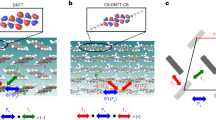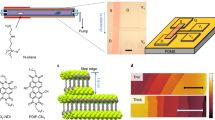Abstract
A highly conductive metallic gas that is quantum mechanically confined at a solid-state interface is an ideal platform to explore non-trivial electronic states that are otherwise inaccessible in bulk materials. Although two-dimensional electron gases have been realized in conventional semiconductor interfaces, examples of two-dimensional hole gases, the counterpart to the two-dimensional electron gas, are still limited. Here we report the observation of a two-dimensional hole gas in solution-processed organic semiconductors in conjunction with an electric double layer using ionic liquids. A molecularly flat single crystal of high-mobility organic semiconductors serves as a defect-free interface that facilitates two-dimensional confinement of high-density holes. A remarkably low sheet resistance of 6 kΩ and high hole-gas density of 1014 cm−2 result in a metal–insulator transition at ambient pressure. The measured degenerate holes in the organic semiconductors provide an opportunity to tailor low-dimensional electronic states using molecularly engineered heterointerfaces.
This is a preview of subscription content, access via your institution
Access options
Access Nature and 54 other Nature Portfolio journals
Get Nature+, our best-value online-access subscription
$29.99 / 30 days
cancel any time
Subscribe to this journal
Receive 12 print issues and online access
$259.00 per year
only $21.58 per issue
Buy this article
- Purchase on Springer Link
- Instant access to full article PDF
Prices may be subject to local taxes which are calculated during checkout




Similar content being viewed by others
Data availability
We declare that all data supporting the findings of this study are included within the paper and its Supplementary Information files. Source data are provided with this paper.
References
Ando, T., Fowler, A. B. & Stern, F. Electronic properties of two-dimensional systems. Rev. Mod. Phys. 54, 437 (1982).
Davies, J. H. The Physics of Low-Dimensional Semiconductors (Cambridge Univ. Press, 1998).
Mimura, T. The early history of the high electron mobility transistor (HEMT). IEEE Trans. Microw. Theory Tech. 50, 780–782 (2002).
Pengelly, R. S., Wood, S. M., Milligan, J. W., Sheppard, S. T. & Pribble, W. L. A review of GaN on SiC high electron-mobility power transistors and MMICs. IEEE Trans. Microw. Theory Tech. 60, 1764–1783 (2012).
Mimura, T., Hiyamizu, S., Fujii, T. & Nanbu, K. A new field-effect transistor with selectively doped GaAs/n-AlxGa1-xAs heterojunctions. Jpn J. Appl. Phys. 19, L225 (1980).
Ambacher, O. et al. Two-dimensional electron gases induced by spontaneous and piezoelectric polarization charges in N- and Ga-face AlGaN/GaN heterostructures. J. Appl. Phys. 85, 3222–3233 (1999).
Ohtomo, A. & Hwang, H. A high-mobility electron gas at the LaAlO3/SrTiO3 heterointerface. Nature 427, 423–426 (2004).
Thiel, S., Hammerl, G., Schmehl, A., Schneider, C. W. & Mannhart, J. Tunable quasi-two-dimensional electron gases in oxide heterostructures. Science 313, 1942–1945 (2006).
Hwang, H. Y. et al. Emergent phenomena at oxide interfaces. Nat. Mater. 11, 103–113 (2012).
Lee, H. et al. Direct observation of a two-dimensional hole gas at oxide interfaces. Nat. Mater. 17, 231–236 (2018).
Chaudhuri, R. et al. A polarization-induced 2D hole gas in undoped gallium nitride quantum wells. Science 365, 1454–1457 (2019).
Chwang, A. B. & Frisbie, C. D. Temperature and gate voltage dependent transport across a single organic semiconductor grain boundary. J. Appl. Phys. 90, 1342–1349 (2001).
Takeya, J., Tsukagoshi, K., Aoyagi, Y., Takenobu, T. & Iwasa, Y. Hall effect of quasi-hole gas in organic single-crystal transistors. Jpn J. Appl. Phys. 44, L1393 (2005).
Podzorov, V., Menard, E., Rogers, J. & Gershenson, M. Hall effect in the accumulation layers on the surface of organic semiconductors. Phys. Rev. Lett. 95, 226601 (2005).
Hulea, I. N. et al. Tunable Fröhlich polarons in organic single-crystal transistors. Nat. Mater. 5, 982–986 (2006).
Takeya, J. et al. In-crystal and surface charge transport of electric-field-induced carriers in organic single-crystal semiconductors. Phys. Rev. Lett. 98, 196804 (2007).
Alves, H., Molinari, A. S., Xie, H. & Morpurgo, A. F. Metallic conduction at organic charge-transfer interfaces. Nat. Mater. 7, 574–580 (2008).
Xia, Y., Xie, W., Ruden, P. P. & Frisbie, C. D. Carrier localization on surfaces of organic semiconductors gated with electrolytes. Phys. Rev. Lett. 105, 036802 (2010).
Wang, S., Ha, M., Manno, M., Frisbie, C. D. & Leighton, C. Hopping transport and the Hall effect near the insulator–metal transition in electrochemically gated poly(3-hexylthiophene) transistors. Nat. Commun. 3, 1210 (2012).
Sakanoue, T. & Sirringhaus, H. Band-like temperature dependence of mobility in a solution-processed organic semiconductor. Nat. Mater. 9, 736–740 (2010).
Hasegawa, T. & Takeya, J. Organic field-effect transistors using single crystals. Sci. Technol. Adv. Mater. 10, 024314 (2009).
Tsurumi, J. et al. Coexistence of ultra-long spin relaxation time and coherent charge transport in organic single-crystal semiconductors. Nat. Phys. 13, 994–998 (2017).
Fratini, S., Ciuchi, S., Mayou, D., De Laissardière, G. T. & Troisi, A. A map of high-mobility molecular semiconductors. Nat. Mater. 16, 998–1002 (2017).
Fratini, S., Nikolka, M., Salleo, A., Schweicher, G. & Sirringhaus, H. Charge transport in high-mobility conjugated polymers and molecular semiconductors. Nat. Mater. 19, 491 (2020).
Mitsui, C. et al. High-performance solution-processable N-shaped organic semiconducting materials with stabilized crystal phase. Adv. Mater. 26, 4546–4551 (2014).
Yamamura, A. et al. Wafer-scale, layer-controlled organic single crystals for high-speed circuit operation. Sci. Adv. 4, eaao5758 (2018).
Okamoto, T. et al. Bent-shaped p-type small-molecule organic semiconductors: a molecular design strategy for next-generation practical applications. J. Am. Chem. Soc. 142, 9083–9096 (2020).
Kumagai, S. et al. Scalable fabrication of organic single-crystalline wafers for reproducible TFT arrays. Sci. Rep. 9, 15897 (2019).
Yamamura, A. et al. High-speed organic single-crystal transistor responding to very high frequency band. Adv. Funct. Mater. 30, 1909501 (2020).
Soeda, J. et al. Inch-size solution-processed single-crystalline films of high-mobility organic semiconductors. Appl. Phys. Express 6, 076503 (2013).
Makita, T. et al. High-performance, semiconducting membrane composed of ultrathin, single-crystal organic semiconductors. Proc. Natl Acad. Sci. USA 117, 80–85 (2020).
Yamamura, A. et al. Sub-molecular structural relaxation at a physisorbed interface with monolayer organic single-crystal semiconductors. Commun. Phys. 3, 20 (2020).
Yokota, Y. et al. Structural investigation of ionic liquid/rubrene single crystal interfaces by using frequency-modulation atomic force microscopy. Chem. Commun. 49, 10596 (2013).
Ovchinnikov, D., Gargiulo, F. & Allain, A. Disorder engineering and conductivity dome in ReS2 with electrolyte gating. Nat. Commun. 7, 12391 (2016).
Keun Hyung Lee, S. Z. Y. G. T. P. L., Moon, S. K. & Frisbie, C. D. ‘Cut and stick’ rubbery ion gels as high capacitance gate dielectrics. Adv. Mater. 24, 4457–4462 (2012).
Takagi, S., Toriumi, A., Iwase, M. & Tango, H. On the universality of inversion layer mobility in Si MOSFET’s: Part I—effects of substrate impurity concentration. IEEE Trans. Electron. Devices 41, 2357–2362 (1994).
Sato, Y., Kawasugi, Y., Suda, M., Yamamoto, H. M. & Kato, R. Critical behavior in doping-driven metal–insulator transition on single-crystalline organic Mott-FET. Nano Lett. 17, 708–714 (2016).
Das Sarma, S. & Hwang, E. H. Two-dimensional metal–insulator transition as a strong localization induced crossover phenomenon. Phys. Rev. B 89, 235423 (2014).
Haitao, S. et al. Ionization energies, electron affinities, and polarization energies of organic molecular crystals: quantitative estimations from a polarizable continuum model (PCM)-tuned range-separated density functional approach. J. Chem. Theory Comput. 12, 2906–2916 (2016).
Okamoto, T., Hosoya, K., Kawaji, S. & Yagi, A. Spin degree of freedom in a two-dimensional electron liquid. Phys. Rev. Lett. 82, 3875–3878 (1999).
A., G. et al. Electron assisted variable range hopping in strongly correlated 2D electron systems. Phys. Status Solidi B 230, 211–216 (2002).
Branimir, R. & Andras, K. Mobility engineering and a metal-insulator transition in monolayer MoS2. Nat. Mater. 12, 815–820 (2013).
Watanabe, S. et al. Remarkably low flicker noise in solution-processed organic single crystal transistors. Commun. Phys. 1, 37 (2018).
Yokota, Y. et al. Microscopic properties of ionic liquid/organic semiconductor interfaces revealed by molecular dynamics simulations. Phys. Chem. Chem. Phys. 20, 13075–13083 (2018).
Demissie, A. T., Haugstad, G. & Frisbie, C. D. Quantitative surface coverage measurements of self-assembled monolayers by nuclear reaction analysis of carbon-12. J. Phys. Chem. Lett. 7, 3477–3481 (2016).
Morisawa, Y., Tachibana, S., Ehara, M. & Ozaki, Y. Elucidating electronic transitions from σ orbitals of liquid n- and branched alkanes by far-ultraviolet spectroscopy and quantum chemical calculations. J. Phys. Chem. A 116, 11957–11964 (2012).
Acknowledgements
S.W. acknowledges the support from the Leading Initiative for Excellent Young Researchers of JSPS. T.O. acknowledges the support from PRESTO-JST through the project ‘Scientific Innovation for Energy Harvesting Technology’ (grant no. JPMJPR17R2). This work was supported by Kakenhi Grants-in-Aid (nos. JP17H06123, JP17H06200, 20H00387) from JSPS, and JST FOREST Program, grant no. JPMJFR2020.
Author information
Authors and Affiliations
Contributions
N.K. conceived, designed and performed the experiments and analysed the data. N.K. and J. Tsurumi performed the density functional theory calculations. T.O. synthesized and purified C8-DNBDT-NW. N.K., S.W. and J. Takeya wrote the manuscript. S.W. and J. Takeya supervised the work. All authors discussed the results and reviewed the manuscript.
Corresponding authors
Ethics declarations
Competing interests
The authors declare no competing interests.
Additional information
Peer review information Nature Materials thanks Mario Caironi and the other, anonymous, reviewer(s) for their contribution to the peer review of this work.
Publisher’s note Springer Nature remains neutral with regard to jurisdictional claims in published maps and institutional affiliations.
Supplementary information
Supplementary Information
Supplementary Figs. A1–D1, Notes A–D and references.
Source data
Source Data Fig. 2
Current–voltage characteristics, gate voltage dependent carrier density and Hall mobility derived from the Hall effect measurements.
Source Data Fig. 3
Temperature dependence of sheet resistance.
Source Data Fig. 4
Temperature dependence of Hall mobility and carrier density.
Source Data in Supplementary information
Sample variation in current–voltage characteristics and magnetotransports.
Rights and permissions
About this article
Cite this article
Kasuya, N., Tsurumi, J., Okamoto, T. et al. Two-dimensional hole gas in organic semiconductors. Nat. Mater. 20, 1401–1406 (2021). https://doi.org/10.1038/s41563-021-01074-4
Received:
Accepted:
Published:
Issue Date:
DOI: https://doi.org/10.1038/s41563-021-01074-4
This article is cited by
-
Enabling metallic behaviour in two-dimensional superlattice of semiconductor colloidal quantum dots
Nature Communications (2023)
-
A solution for two-dimensional hole gases
Nature Materials (2021)



